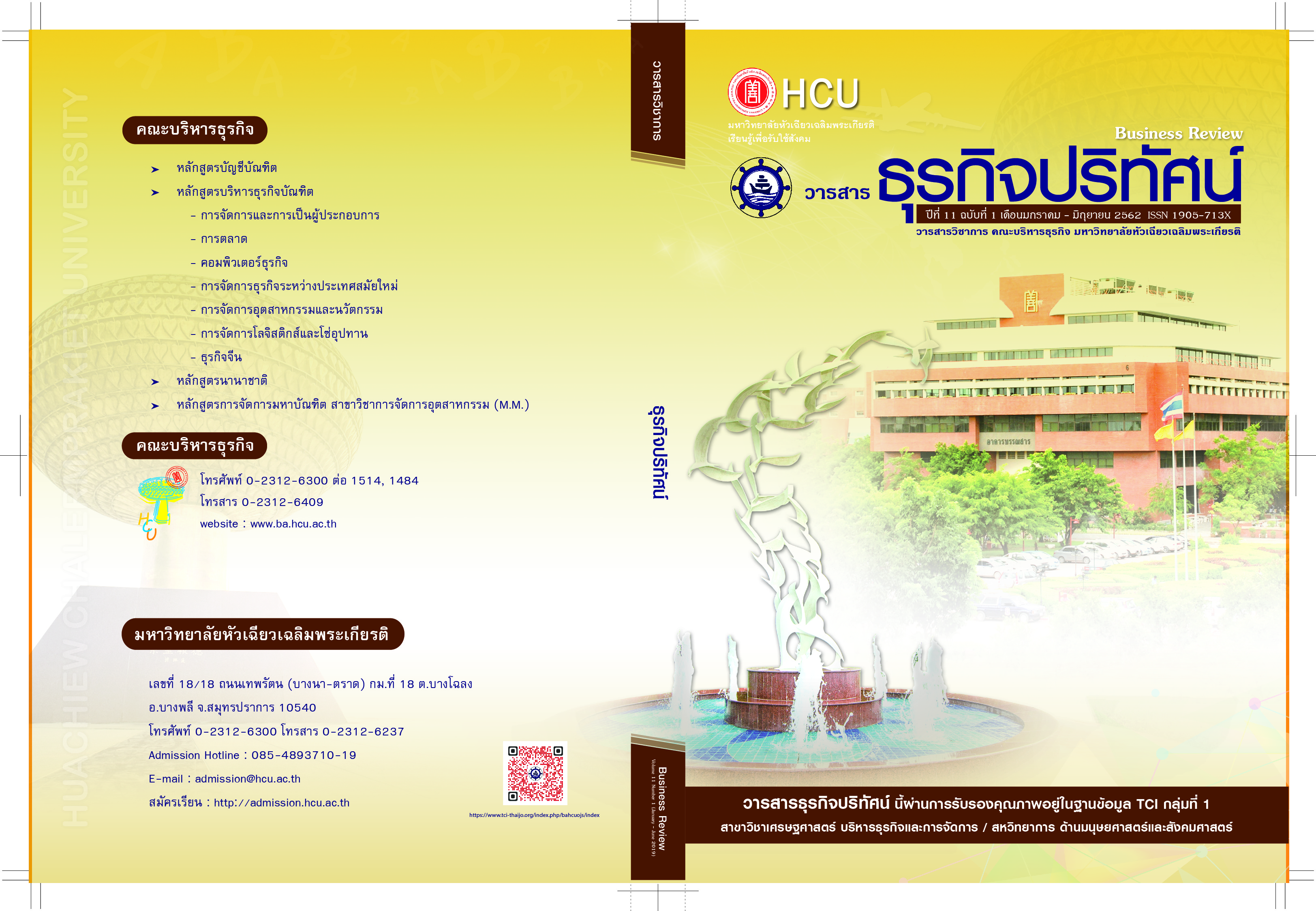อิทธิพลของการบริหารลูกค้าสัมพันธ์และภาวะผู้นำด้านการประกอบการที่มีต่อ ผลการดำเนินงานของธุรกิจบริการผู้สูงอายุ
คำสำคัญ:
การบริหารลูกค้าสัมพันธ์, ภาวะผู้นำด้านการประกอบการ, ธุรกิจบริการดูแลผู้สูงอายุบทคัดย่อ
การวิจัยครั้งนี้มีวัตถุประสงค์เพื่อ 1) ศึกษาระดับของการบริหารลูกค้าสัมพันธ์ ภาวะผู้นำ
ด้านการประกอบการ และผลการดำเนินงานของธุรกิจบริการดูแลผู้สูงอายุ และ 2) ศึกษาอิทธิพล
ของการบริหารลูกค้าสัมพันธ์และภาวะผู้นำด้านการประกอบการที่มีต่อผลการดำเนินงานของธุรกิจ
บริการดูแลผ้สู ูงอายุ การวิจัยนี้ใช้วิธีการวิจัยเชิงปริมาณ มีกล่มุ ตัวอย่าง คือ ผ้ปู ระกอบการของธุรกิจ
บริการดูแลผู้สูงอายุในเขตกรุงเทพและปริมณฑล จำนวน 220 ราย ด้วยวิธีการสุ่มตัวอย่างแบบเป็น
ระบบ ซึ่งกำหนดขนาดของกลุ่มตัวอย่างโดยใช้เกณฑ์ 10 เท่าของตัวแปรสังเกตได้ ใช้แบบสอบถาม
ในการเก็บข้อมูล สถิติที่ใช้ในการวิเคราะห์ข้อมูล คือ ค่าเฉลี่ย ส่วนเบี่ยงเบนมาตรฐาน และการ
วิเคราะห์สมการโครงสร้าง ผลการวิจัยพบว่า 1) ระดับของการบริหารลูกค้าสัมพันธ์ ภาวะผู้นำด้าน
การประกอบการและผลการดำเนินงานภาพรวมอยู่ในระดับมาก และ 2) การบริหารลูกค้าสัมพันธ์
และภาวะผู้นำด้านการประกอบการมีอิทธิพลทางตรงต่อผลการดำเนินงานของธุรกิจบริการดูแล
ผู้สูงอายุ อย่างมีนัยสำคัญทางสถิติที่ระดับ .05
เอกสารอ้างอิง
สืบค้นเมื่อ 15 มกราคม 2561, จาก กรมพัฒนาธุรกิจการค้า กระทรวงพาณิชย์ เว็บไซต์: http://
www.dbd.go.th/mobile/news_view.php?nid=469404775.
กุณฑลี รื่นรมย์. (2547). การมุ่งเน้นลูกค้าและตลาด: สร้างองค์กรให้แตกต่างอย่างเหนือชั้น. กรุงเทพฯ:
อินโนกราฟฟิกส์.
ผู้จัดการออนไลน์. (2560). ธุรกิจบริการผู้สูงอายุโตแรง “พาณิชย์” เร่งสร้างบุคลากรมืออาชีพเข้าท?ำงาน.
สืบค้นเมื่อ 15 มกราคม 2561, จาก ผู้จัดการออนไลน์ เว็บไซต์: https://mgronline.com/smes/
detail/9600000074327.
ลภัสรดา โกมุทพงศ์ และประสพชัย พสุนนท์. (2559). ปัจจัยที่มีผลต่อการสืบทอดกิจการของทายาทธุรกิจ
เพศหญิงในประเทศไทย. วารสารธุรกิจปริทัศน์, 8(1), 103-117.
Assche, T. V. (2005). The impact of entrepreneurial leadership on EU high politics: A case study
of jacques delores and the creation of EMU. Retrieved January 5, 2017, from Syracuse
University, USA Website: http://www. lea.sagepub. com/cgi/ content/ abstract/1/3/279.
Chien, S. (2014). Franchisor resources, spousal resources, entrepreneurial orientation, and performance
in a couple-owned franchise outlet. Management Decision, 52(5), 916-933.
Cho, T. (2011). Knowledge management capabilities and organizational performance: An investigation
into the effects of knowledge infrastructure and processes on organizational performance.
Ph.D. Dissertation, University of Illinois at Urbana-Champaign, USA.
Fernald, L.W., Soloman, G.T., & Tarabishy, A. (2005). A new paradigm: entrepreneurial leadership.
Southern Business Review, 30(2), 1-10.
Fontana, A., & Musa, S. (2017). The impact of entrepreneurial leadership on innovation management
and its measurement validation. International Journal of Innovation Science, 9(1), 2-19.
Frese, M. (2000). Success and failure of micro business owners in Africa. USA: Greenwood
Publishing.
Gray, J.H., Densten, I.L., & Sarros, J.C. (2003). Size matters: organisational culture in small, medium,
and large Australian organizations. Journal of Small Business and Entrepreneurship,
17(1), 31-46.
Gupta, V., MacMillan, I.C., & Surie, G. (2004). Entrepreneurial leadership: developing and
measuring a cross-cultural construct. Journal of Business Venturing, 19(2), 241-260.
Hair, J.F., Black, W.C., Babin, B.J., & Anderson, R.E. (2010). Multivariate data analysis: A global
perspective (7th ed.). Upper Saddle River: Pearson Education.
Hansson, F., & Monsted, M. (2008). Research leadership as entrepreneurial organizing for research.
Higher Education, 55(6), 651-670.
Keramati, A., Mehrabi, H., & Mojir, N. (2010). A process-oriented perspective on customer
relationship management and organizational performance: an empirical investigation.
Industrial Marketing Management, 39(7), 1170-1185.
Kim, H., & Kim, Y. (2009). A CRM performance measurement framework: Its development process
and application. Industrial Marketing Management, 38(4), 477-489.
Lee, M. K. O., & Turban, E. (2001). A trust model for consumer internet shopping. International
Journal of Electronic Commerce, 6 (1), 75-91.
Lin, R.J., Chen, R.H., & Chiu, K.K.S. (2010). Customer relationship management and innovation
capability: an empirical study. Industrial Management & Data Systems, 110(1), 111-133.
Ngai, E. W. T. (2005). Customer relationship management research. An academic literature review
and classification. Journal of Marketing, 39(11/12), 582-605.
Reinartz, W., Krafft, M., & Hoyer, W.D. (2004). The customer relationship management process:
Its measurement and impact on performance. Journal of Marketing Research, 41(3), 293-305.
Roh, T.H., Ahn, C.K., & Han, I. (2005). The priority factor model for customer relationship
management system success. Expert Systems with Applications, 28(4), 641-654.
Ruvio, A., Rosenblatt, Z., & Hertz-Lazarowitz, R. (2010). Entrepreneurial leadership vision in
nonprofit vs for-profit organizations. The Leadership Quarterly, 21(1), 144-158.
Schoder, D., & Madeja, N. (2004). Is customer relationship management a success factor in
electronic commerce?. Journal of Electronic Commerce Research, 5(1), 2004.
Suprapto, B., Wahab, H.A., & Wibowo. A.J. (2009). The implementation of balance score card for
performance measurement in small and medium enterprises: Evidence from Malaysian Health
Care Services. The Asian Journal of Technology Management, 2(2), 37-49
United Nations. (2015). World Population Ageing 2015. Retrieved January 15, 2017, from United
Nations Website: http://www.un.org/en/development/desa/population/publications/pdf/ageing/
WPA2015_Report.pdf.
Valmohammadi, C., & Beladpas, M. (2014). Customer relationship management and service quality:
a survey within the banking sector. Industrial and Commercial Training, 46(2), 77-83.
ดาวน์โหลด
เผยแพร่แล้ว
รูปแบบการอ้างอิง
ฉบับ
ประเภทบทความ
สัญญาอนุญาต
บทความที่ได้รับการตีพิมพ์จะเป็นลิขสิทธิ์ของวารสารธุรกิจปริทัศน์
ข้อความที่ปรากฏในบทความแต่ละเรื่องในวารสารวิชาการเล่มนี้เป็นความคิดเห็นส่วนตัวของผู้เขียนแต่ละท่านไม่เกี่ยวข้องกับมหาวิทยาลัยหัวเฉียวเฉลิมพระเกียรติ และคณาจารย์ท่านอื่น ๆ ในมหาวิทยาลัยฯ แต่อย่างใด ความรับผิดชอบองค์ประกอบทั้งหมดของบทความแต่ละเรื่องเป็นของผู้เขียนแต่ละท่าน หากมีความผิดพลาดใด ๆ ผู้เขียนแต่ละท่านจะรับผิดชอบบทความของตนเองแต่ผู้เดียว





